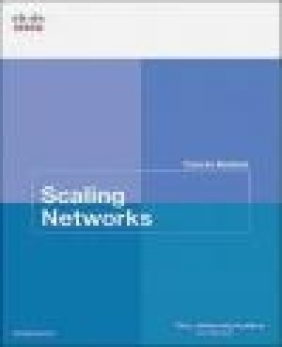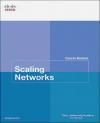Scaling Networks Course Booklet
Scaling Networks Course Booklet
- Producent: Cisco Press
- Rok produkcji: 2013
- ISBN: 9781587133244
- Ilość stron: 250
- Oprawa: Miękka
Niedostępna
Opis: Scaling Networks Course Booklet
Scaling Networks Course Booklet Your Cisco(R) Networking Academy(R) Course Booklet is designed as a study resource you can easily read, highlight, and review on the go, wherever the Internet is not available or practical: * The text is extracted directly, word-for-word, from the online course so you can highlight important points and take notes in the "Your Chapter Notes" section. * Headings with the exact page correlations provide a quick reference to the online course for your classroom discussions and exam preparation. * An icon system directs you to the online curriculum to take full advantage of the images embedded within the Networking Academy online course interface and reminds you to perform the labs, Class Activities, interactive activities, Packet Tracer activities, chapter quizzes, and exams. The Course Booklet is a basic, economical paper-based resource to help you succeed with the Cisco Networking Academy online course. Related Titles: Scaling Networks Lab Manual Book: 978-1-58713-325-1 Scaling Networks Companion Guide Book: 978-1-58713-328-2 eBook: 978-0-13-347640-8 CCNA Routing and Switching Practice and Study Guide Book: 978-1-58713-344-2 eBook: 978-0-13-351761-3 CCNA Routing and Switching Portable Command Guide Book: 978-1-58720-430-2 eBook: 978-0-13-338136-8Chapter 0 Course Introduction 1 0.0 Scaling Networks 1 0.0.1 Message to the Student 1 0.0.1.1 Welcome 1 0.0.1.2 A Global Community 1 0.0.1.3 More Than Just Information 1 0.0.1.4 How We Teach 2 0.0.1.5 Practice Leads to Mastery 2 0.0.1.6 Mind Wide Open 2 0.0.1.7 Engineering Journals 2 0.0.1.8 Explore the World of Networking 2 0.0.1.9 Create Your Own Worlds 3 0.0.1.10 How Packet Tracer Helps Master Concepts 3 0.0.1.11 Course Overview 3 0.1.1.1 Course GUI Tutorial 4 Your Chapter Notes 5 Chapter 1 Introduction to Scaling Networks 7 1.0 Introduction to Scaling Networks 7 1.0.1.1 Introduction 7 1.0.1.2 Class Activity - Network by Design 7 1.1 Implementing a Network Design 7 1.1.1 Hierarchical Network Design 7 1.1.1.1 The Need to Scale the Network 7 1.1.1.2 Enterprise Business Devices 8 1.1.1.3 Hierarchical Network Design 8 1.1.1.4 Cisco Enterprise Architecture 9 1.1.1.5 Failure Domains 10 1.1.1.6 Activity - Identify Cisco Enterprise Architecture Modules 10 1.1.2 Expanding the Network 10 1.1.2.1 Design for Scalability 10 1.1.2.2 Planning for Redundancy 11 1.1.2.3 Increasing Bandwidth 12 1.1.2.4 Expanding the Access Layer 12 1.1.2.5 Fine-tuning Routing Protocols 12 1.1.2.6 Activity: Identify Scalability Terminology 13 1.2 Selecting Network Devices 13 1.2.1 Switch Hardware 13 1.2.1.1 Switch Platforms 13 1.2.1.2 Port Density 14 1.2.1.3 Forwarding Rates 15 1.2.1.4 Power over Ethernet 15 1.2.1.5 Multilayer Switching 15 1.2.1.6 Activity - Selecting Switch Hardware 16 1.2.1.7 Packet Tracer - Comparing 2960 and 3560 Switches 16 1.2.1.8 Lab - Selecting Switching Hardware 16 1.2.2 Router Hardware 16 1.2.2.1 Router Requirements 16 1.2.2.2 Cisco Routers 17 1.2.2.3 Router Hardware 17 1.2.2.4 Activity - Identify the Router Category 17 1.2.3 Managing Devices 17 1.2.3.1 Managing IOS Files and Licensing 17 1.2.3.2 In-Band versus Out-of-Band Management 18 1.2.3.3 Basic Router CLI Commands 18 1.2.3.4 Basic Router Show Commands 18 1.2.3.5 Basic Switch CLI commands 19 1.2.3.6 Basic Switch Show Commands 20 1.3 Summary 20 1.3.1.1 Class Activity - Layered Network Design Simulation 20 1.3.1.2 Basic Switch Configurations 21 1.3.1.3 Packet Tracer - Skills Integration Challenge 21 1.3.1.4 Summary 21 Your Chapter Notes 22 Chapter 2 LAN Redundancy 23 2.0 LAN Redundancy 23 2.0.1.1 Introduction 23 2.0.1.2 Class Activity - Stormy Traffic 23 2.1 Spanning Tree Concepts 24 2.1.1 Purpose of Spanning Tree 24 2.1.1.1 Redundancy at OSI Layers 1 and 2 24 2.1.1.2 Issues with Layer 1 Redundancy: MAC Database Instability 25 2.1.1.3 Issues with Layer 1 Redundancy: Broadcast Storms 26 2.1.1.4 Issues with Layer 1 Redundancy: Duplicate Unicast Frames 26 2.1.1.5 Packet Tracer - Examining a Redundant Design 27 2.1.2 STP Operation 27 2.1.2.1 Spanning Tree Algorithm: Introduction 27 2.1.2.2 Spanning Tree Algorithm: Port Roles 29 2.1.2.3 Spanning Tree Algorithm: Root Bridge 30 2.1.2.4 Spanning Tree Algorithm: Path Cost 30 2.1.2.5 802.1D BPDU Frame Format 31 2.1.2.6 BPDU Propagation and Process 32 2.1.2.7 Extended System ID 33 2.1.2.8 Activity - Identify 802.1D Port Roles 34 2.1.2.9 Video Demonstration - Observing Spanning Tree Protocol Operation 34 2.1.2.10 Lab - Building a Switched Network with Redundant Links 34 2.2 Varieties of Spanning Tree Protocols 35 2.2.1 Overview 35 2.2.1.1 List of Spanning Tree Protocols 35 2.2.1.2 Characteristics of the Spanning Tree Protocols 35 2.2.1.3 Activity - Identify Types of Spanning Tree Protocols 37 2.2.2 PVST+ 37 2.2.2.1 Overview of PVST+ 37 2.2.2.2 Port States and PVST+ Operation 37 2.2.2.3 Extended System ID and PVST+ Operation 38 2.2.2.4 Activity - Identifying PVST+ Operation 39 2.2.3 Rapid PVST+ 39 2.2.3.1 Overview of Rapid PVST+ 39 2.2.3.2 RSTP BPDU 40 2.2.3.3 Edge Ports 40 2.2.3.4 Link Types 41 2.2.3.5 Activity - Identify Port Roles in Rapid PVST+ 41 2.2.3.6 Activity - Compare PVST+ and Rapid PVST+ 41 2.3 Spanning Tree Configuration 41 2.3.1 PVST+ Configuration 41 2.3.1.1 Catalyst 2960 Default Configuration 41 2.3.1.2 Configuring and Verifying the Bridge ID 42 2.3.1.3 PortFast and BPDU Guard 42 2.3.1.4 PVST+ Load Balancing 43 2.3.1.5 Packet Tracer - Configuring PVST+ 44 2.3.2 Rapid PVST+ Configuration 44 2.3.2.1 Spanning Tree Mode 44 2.3.2.2 Packet Tracer - Configuring Rapid PVST+ 45 2.3.2.3 Lab - Configuring Rapid PVST+, PortFast and BPDU Guard 45 2.3.3 STP Configuration Issues 46 2.3.3.1 Analyzing the STP Topology 46 2.3.3.2 Expected Topology versus Actual Topology 46 2.3.3.3 Overview of Spanning Tree Status 46 2.3.3.4 Spanning Tree Failure Consequences 47 2.3.3.5 Repairing a Spanning Tree Problem 48 2.3.3.6 Activity - Troubleshoot STP Configuration Issues 48 2.4 First Hop Redundancy Protocols 48 2.4.1 Concept of First Hop Redundancy Protocols 48 2.4.1.1 Default Gateway Limitations 48 2.4.1.2 Router Redundancy 49 2.4.1.3 Steps for Router Failover 49 2.4.1.4 Activity - Identify FHRP Terminology 49 2.4.2 Varieties of First Hop Redundancy Protocols 49 2.4.2.1 First Hop Redundancy Protocols 49 2.4.2.2 Activity - Identify the Type of FHRP 50 2.4.3 FHRP Verification 50 2.4.3.1 HSRP Verification 50 2.4.3.2 GLBP Verification 51 2.4.3.3 Syntax Checker - HSRP and GLBP 51 2.4.3.4 Lab - Configuring HSRP and GLBP 52 2.5 Summary 52 2.5.1.1 Class Activity - Documentation Tree 52 2.5.1.2 Summary 52 Your Chapter Notes 54 Chapter 3 Link Aggregation 55 3.0 Introduction 55 3.0.1.1 Introduction 55 3.0.1.2 Class Activity - Imagine This 55 3.1 Link Aggregation Concepts 56 3.1.1 Link Aggregation 56 3.1.1.1 Introduction to Link Aggregation 56 3.1.1.2 Advantages of EtherChannel 56 3.1.2 EtherChannel Operation 57 3.1.2.1 Implementation Restrictions 57 3.1.2.2 Port Aggregation Protocol 57 3.1.2.3 Link Aggregation Control Protocol 58 3.1.2.4 Activity - Identify the PAgP and LACP Modes 59 3.2 Link Aggregation Configuration 59 3.2.1 Configuring EtherChannel 59 3.2.1.1 Configuration Guidelines 59 3.2.1.2 Configuring Interfaces 60 3.2.1.3 Packet Tracer - Configuring EtherChannel 60 3.2.1.4 Lab - Configuring EtherChannel 61 3.2.2 Verifying and Troubleshooting EtherChannel 61 3.2.2.1 Verifying EtherChannel 61 3.2.2.2 Troubleshooting EtherChannel 61 3.2.2.3 Packet Tracer - Troubleshooting EtherChannel 62 3.2.2.4 Lab - Troubleshooting EtherChannel 62 3.3 Summary 63 3.3.1.1 Class Activity - Linking Up 63 3.3.1.2 Packet Tracer - Skills Integration Challenge 63 3.3.1.3 Summary 63 Your Chapter Notes 64 Chapter 4 Wireless LANs 65 4.0 Introduction 65 4.0.1.1 Introduction 65 4.0.1.2 Class Activity - Make Mine Wireless 65 4.1 Wireless Concepts 65 4.1.1 Introduction to Wireless 65 4.1.1.1 Supporting Mobility 65 4.1.1.2 Benefits of Wireless 66 4.1.1.3 Wireless Technologies 67 4.1.1.4 Radio Frequencies 67 4.1.1.5 802.11 Standards 68 4.1.1.6 Wi-Fi Certification 69 4.1.1.7 Comparing WLANs to a LAN 70 4.1.1.8 Activity - Identify the Wireless Technology 71 4.1.1.9 Activity - Compare Wireless Standards 71 4.1.1.10 Activity - Compare WLANs and LANs 71 4.1.2 Components of WLANs 71 4.1.2.1 Wireless NICs 71 4.1.2.2 Wireless Home Router 71 4.1.2.3 Business Wireless Solutions 72 4.1.2.4 Wireless Access Points 72 4.1.2.5 Small Wireless Deployment Solutions 73 4.1.2.6 Large Wireless Deployment Solutions 74 4.1.2.7 Large Wireless Deployment Solutions, Cont. 75 4.1.2.8 Wireless Antennas 75 4.1.2.9 Activity - Identify WLAN Component Terminology 76 4.1.2.10 Lab - Investigating Wireless Implementations 76 4.1.3 802.11 WLAN Topologies 76 4.1.3.1 802.11 Wireless Topology Modes 76 4.1.3.2 Ad Hoc Mode 77 4.1.3.3 Infrastructure Mode 77 4.1.3.4 Activity - Identify WLAN Topology Terminology 78 4.2 Wireless LAN Operations 78 4.2.1 802.11 Frame Structure 78 4.2.1.1 Wireless 802.11 Frame 78 4.2.1.2 Frame Control Field 79 4.2.1.3 Wireless Frame Type 79 4.2.1.4 Management Frames 80 4.2.1.5 Control Frames 81 4.2.1.6 Activity - Identify the 802.11 Frame Control Fields 81 4.2.2 Wireless Operation 81 4.2.2.1 Carrier Sense Multiple Access with Collision Avoidance 81 4.2.2.2 Wireless Clients and Access Point Association 82 4.2.2.3 Association Parameters 82 4.2.2.4 Discovering APs 83 4.2.2.5 Authentication 84 4.2.2.6 Activity - Order the Steps in the Client and AP Association Process 84 4.2.3 Channel Management 85 4.2.3.1 Frequency Channel Saturation 85 4.2.3.2 Selecting Channels 85 4.2.3.3 Planning a WLAN Deployment 86 4.2.3.4 Activity - Identify Channel Management Terminology 87 4.2.3.5 Activity - Cisco Wireless Explorer Game 87 4.3 Wireless LAN Security 87 4.3.1 WLAN Threats 87 4.3.1.1 Securing Wireless 87 4.3.1.2 DoS Attack 88 4.3.1.3 Management Frame DoS Attacks 88 4.3.1.4 Rogue Access Points 89 4.3.1.5 Man-in-the-Middle Attack 90 4.3.2 Securing WLANs 91 4.3.2.1 Wireless Security Overview 91 4.3.2.2 Shared Key Authentication Methods 91 4.3.2.3 Encryption Methods 92 4.3.2.4 Authenticating a Home User 92 4.3.2.5 Authentication in the Enterprise 93 4.3.2.6 Activity - Identify the WLAN Authentication Characteristics 93 4.4 Wireless LAN Configuration 94 4.4.1 Configure a Wireless Router 94 4.4.1.1 Configuring a Wireless Router 94 4.4.1.2 Setting Up and Installed Initial Linksys EAS6500 94 4.4.1.3 Configuring the Linksys Smart Wi-Fi Homepage 95 4.4.1.4 Smart Wi-Fi Settings 96 4.4.1.5 Smart Wi-Fi Tools 96 4.4.1.6 Backing Up a Configuration 97 4.4.2 Configuring Wireless Clients 97 4.4.2.1 Connecting Wireless Clients 97 4.4.2.2 Packet Tracer - Configuring Wireless LAN Access 97 4.4.2.3 Lab - Configuring a Wireless Router and Client 97 4.4.3 Troubleshoot WLAN Issues 98 4.4.3.1 Troubleshooting Approaches 98 4.4.3.2 Wireless Client Not Connecting 98 4.4.3.3 Troubleshooting When the Network Is Slow 99 4.4.3.4 Updating Firmware 100 4.4.3.5 Activity - Identify the Troubleshooting Solution 100 4.5 Summary 100 4.5.1.1 Class Activity - Inside and Outside Control 100 4.5.1.2 Packet Tracer - Skills Integration Challenge 101 4.5.1.3 Summary 101 Your Chapter Notes 102 Chapter 5 Adjust and Troubleshoot Single-Area OSPF 103 5.0 Adjust and Troubleshoot Single-Area OSPF 103 5.0.1.1 Introduction 103 5.0.1.2 Class Activity - DR and BDR Election 103 5.1 Advanced Single-Area OSPF Configurations 103 5.1.1 Routing in the Distribution and Core Layers 103 5.1.1.1 Routing versus Switching 103 5.1.1.2 Static Routing 104 5.1.1.3 Dynamic Routing Protocols 104 5.1.1.4 Open Shortest Path First 105 5.1.1.5 Configuring Single-Area OSPF 105 5.1.1.6 Verifying Single-Area OSPF 106 5.1.1.7 Configuring Single-Area OSPFv3 106 5.1.1.8 Verifying Single-Area OSPFv3 107 5.1.1.9 Lab - Configuring Basic Single-Area OSPFv2 107 5.1.2 OSPF in Multiaccess Networks 107 5.1.2.1 OSPF Network Types 107 5.1.2.2 Challenges in Multiaccess Networks 108 5.1.2.3 OSPF Designated Router 108 5.1.2.4 Verifying DR/BDR Roles 109 5.1.2.5 Verifying DR/BDR Adjacencies 110 5.1.2.6 Default DR/BDR Election Process 111 5.1.2.7 DR/BDR Election Process 112 5.1.2.8 The OSPF Priority 112 5.1.2.9 Changing the OSPF Priority 113 5.1.2.10 Activity - Identify OSPF Network Type Terminology 113 5.1.2.11 Activity - Select the Designated Router 113 5.1.2.12 Packet Tracer - Determining the DR and BDR 113 5.1.2.13 Lab - Configuring OSPFv2 on a Multiaccess Network 114 5.1.3 Default Route Propagation 114 5.1.3.1 Propagating a Default Static Route in OSPFv2 114 5.1.3.2 Verifying the Propagated Default Route 114 5.1.3.3 Propagating a Default Static Route in OSPFv3 115 5.1.3.4 Verifying the Propagated IPv6 Default Route 115 5.1.3.5 Packet Tracer - Propagating a Default Route in OSPFv2 115 5.1.4 Fine-tuning OSPF Interfaces 116 5.1.4.1 OSPF Hello and Dead Intervals 116 5.1.4.2 Modifying OSPFv2 Intervals 116 5.1.4.3 Modifying OSPFv3 Intervals 117 5.1.5 Secure OSPF 118 5.1.5.1 Routers are Targets 118 5.1.5.2 Secure Routing Updates 118 5.1.5.3 MD5 Authentication 119 5.1.5.4 Configuring OSPF MD5 Authentication 119 5.1.5.5 OSPF MD5 Authentication Example 120 5.1.5.6 Verifying OSPF MD5 Authentication 120 5.1.5.7 Packet Tracer - Configuring OSPFv2 Advance Features 120 5.1.5.8 Lab - Configuring OSPFv2 Advance Features 121 5.2 Troubleshooting Single-Area OSPF Implementations 121 5.2.1 Components of Troubleshooting Single-Area OSPF 121 5.2.1.1 Overview 121 5.2.1.2 OSPF States 121 5.2.1.3 OSPF Troubleshooting Commands 121 5.2.1.4 Components of Troubleshooting OSPF 122 5.2.1.5 Activity - Identify the Troubleshooting Command 123 5.2.2 Troubleshoot Single-Area OSPFv2 Routing Issues 123 5.2.2.1 Troubleshooting Neighbor Issues 123 5.2.2.2 Troubleshooting OSPF Routing Table Issues 124 5.2.2.3 Packet Tracer - Troubleshooting Single-Area OSPFv2 124 5.2.3 Troubleshoot Single-Area OSPFv3 Routing Issues 124 5.2.3.1 OSPFv3 Troubleshooting Commands 124 5.2.3.2 Troubleshooting OSPFv3 125 5.2.3.3 Lab - Troubleshooting Basic Single-Area OSPFv2 and OSPFv3 125 5.2.3.4 Lab - Troubleshooting Advanced Single-Area OSPFv2 126 5.3 Summary 126 5.3.1.1 Class Activity - OSPF Troubleshooting Mastery 126 5.3.1.2 Packet Tracer - Skills Integration Challenge 126 5.3.1.3 Summary 126 Your Chapter Notes 128 Chapter 6 Multiarea OSPF 129 6.0 Multiarea OSPF 129 6.0.1.1 Introduction 129 6.0.1.2 Class Activity - Leaving on a Jet Plane 129 6.1 Multiarea OSPF Operation 129 6.1.1 Why Multiarea OSPF? 129 6.1.1.1 Single-Area OSPF 129 6.1.1.2 Multiarea OSPF 130 6.1.1.3 OSPF Two-Layer Area Hierarchy 131 6.1.1.4 Types of OSPF Routers 131 6.1.1.5 Activity - Identify the Multiarea OSPF Terminology 132 6.1.2 Multiarea OSPF LSA Operation 132 6.1.2.1 OSPF LSA Types 132 6.1.2.2 OSPF LSA Type 1 132 6.1.2.3 OSPF LSA Type 2 132 6.1.2.4 OSPF LSA Type 3 133 6.1.2.5 OSPF LSA Type 4 133 6.1.2.6 OSPF LSA Type 5 134 6.1.2.7 Activity - Identify the OSPF LSA Type 134 6.1.3 OSPF Routing Table and Types of Routes 134 6.1.3.1 OSPF Routing Table Entries 134 6.1.3.2 OSPF Route Calculation 134 6.1.3.3 Activity - Order the Steps for OSPF Best Path Calculations 135 6.2 Configuring Multiarea OSPF 135 6.2.1 Configuring Multiarea OSPF 135 6.2.1.1 Implementing Multiarea OSPF 135 6.2.1.2 Configuring Multiarea OSPF 136 6.2.1.3 Configuring Multiarea OSPFv3 136 6.2.2 OSPF Route Summarization 137 6.2.2.1 OSPF Route Summarization 137 6.2.2.2 Interarea and External Route Summarization 137 6.2.2.3 Interarea Route Summarization 138 6.2.2.4 Calculating the Summary Route 138 6.2.2.5 Configuring Interarea Route Summarization 138 6.2.3 Verifying Multiarea OSPF 139 6.2.3.1 Verifying Multiarea OSPF 139 6.2.3.2 Verify General Multiarea OSPF Settings 140 6.2.3.3 Verify the OSPF Routes 140 6.2.3.4 Verify the Multiarea OSPF LSDB 140 6.2.3.5 Verify Multiarea OSPFv3 141 6.2.3.6 Packet Tracer - Configuring Multiarea OSPFv2 141 6.2.3.7 Packet Tracer - Configuring Multiarea OSPFv3 141 6.2.3.8 Lab - Configuring Multiarea OSPFv2 141 6.2.3.9 Lab - Configuring Multiarea OSPFv3 141 6.2.3.10 Lab - Troubleshooting Multiarea OSPFv2 and OSPFv3 142 6.3 Summary 142 6.3.1.1 Class Activity - Digital Trolleys 142 6.3.1.2 Summary 142 Your Chapter Notes 144 Chapter 7 EIGRP 145 7.0 EIGRP 145 7.0.1.1 Introduction 145 7.0.1.2 Class Activity - Classless EIGRP 145 7.1 Characteristics of EIGRP 145 7.1.1 Basic Features of EIGRP 145 7.1.1.1 Features of EIGRP 145 7.1.1.2 Protocol Dependent Modules 146 7.1.1.3 Reliable Transport Protocol 147 7.1.1.4 Authentication 147 7.1.2 Types of EIGRP Packets 148 7.1.2.1 EIGRP Packet Types 148 7.1.2.2 EIGRP Hello Packets 149 7.1.2.3 EIGRP Update and Acknowledgment Packets 149 7.1.2.4 EIGRP Query and Reply Packets 150 7.1.2.5 Activity - Identify the EIGRP Packet Type 150 7.1.2.6 Video Demonstration - Observing EIGRP Protocol Communications 150 7.1.3 EIGRP Messages 150 7.1.3.1 Encapsulating EIGRP Messages 150 7.1.3.2 EIGRP Packet Header and TLV 151 7.2 Configuring EIGRP for IPv4 152 7.2.1 Configuring EIGRP with IPv4 152 7.2.1.1 EIGRP Network Topology 152 7.2.1.2 Autonomous System Numbers 152 7.2.1.3 The Router EIGRP Command 153 7.2.1.4 EIGRP Router ID 154 7.2.1.5 Configuring the EIGRP Router ID 155 7.2.1.6 The Network Command 155 7.2.1.7 The Network Command and Wildcard Mask 156 7.2.1.8 Passive Interface 157 7.2.2 Verifying EIGRP with IPv4 158 7.2.2.1 Verifying EIGRP: Examining Neighbors 158 7.2.2.2 Verifying EIGRP: show ip protocols Command 159 7.2.2.3 Verifying EIGRP: Examine the IPv4 routing table 159 7.2.2.4 Packet Tracer - Configuring Basic EIGRP with IPv4 160 7.2.2.5 Lab - Configuring Basic EIGRP with IPv4 161 7.3 Operation of EIGRP 161 7.3.1 EIGRP Initial Route Discovery 161 7.3.1.1 EIGRP Neighbor Adjacency 161 7.3.1.2 EIGRP Topology Table 161 7.3.1.3 EIGRP Convergence 162 7.3.1.4 Activity - Identify the Steps in Establishing EIGRP Neighbor Adjacencies 162 7.3.2 Metrics 162 7.3.2.1 EIGRP Composite Metric 162 7.3.2.2 Examining Interface Values 163 7.3.2.3 Bandwidth Metric 164 7.3.2.4 Delay Metric 165 7.3.2.5 How to Calculate the EIGRP Metric 165 7.3.2.6 Calculating the EIGRP Metric 165 7.3.2.7 Activity - Calculate the EIGRP Metric 166 7.3.3 DUAL and the Topology Table 166 7.3.3.1 DUAL Concepts 166 7.3.3.2 Introduction to DUAL 166 7.3.3.3 Successor and Feasible Distance 167 7.3.3.4 Feasible Successors, Feasibility Condition, and Reported Distance 167 7.3.3.5 Topology Table: show ip eigrp topology Command 168 7.3.3.6 Topology Table: show ip eigrp topology Command (Cont.) 168 7.3.3.7 Topology Table: No Feasible Successor 169 7.3.3.8 Activity - Determine the Feasible Successor 170 7.3.4 DUAL and Convergence 170 7.3.4.1 DUAL Finite State Machine (FSM) 170 7.3.4.2 DUAL: Feasible Successor 170 7.3.4.3 DUAL: No Feasible Successor 171 7.3.4.4 Packet Tracer - Investigating DUAL FSM 171 7.4 Configuring EIGRP for IPv6 172 7.4.1 EIGRP for IPv4 vs. IPv6 172 7.4.1.1 EIGRP for IPv6 172 7.4.1.2 Comparing EIGRP for IPv4 and IPv6 172 7.4.1.3 IPv6 Link-local Addresses 173 7.4.1.4 Activity - Compare EIGRPv4 and EIGRPv6 174 7.4.2 Configuring EIGRP for IPv6 174 7.4.2.1 EIGRP for IPv6 Network Topology 174 7.4.2.2 Configuring IPv6 Link-local Addresses 174 7.4.2.3 Configuring the EIGRP for IPv6 Routing Process 175 7.4.2.4 ipv6 eigrp Interface Command 176 7.4.3 Verifying EIGRP for IPv6 176 7.4.3.1 Verifying EIGRP for IPv6: Examining Neighbors 176 7.4.3.2 Verifying EIGRP for IPv6: show ip protocols Command 177 7.4.3.3 Verifying EIGRP for IPv6: Examine the IPv6 Routing Table 178 7.4.3.4 Packet Tracer - Configuring Basic EIGRP with IPv6 178 7.4.3.5 Lab - Configuring Basic EIGRP for IPv6 179 7.5 Summary 179 7.5.1.1 Class Activity - Portfolio RIP and EIGRP 179 7.5.1.2 Summary 179 Your Chapter Notes 181 Chapter 8 EIGRP Advanced Configurations and Troubleshooting 183 8.0 EIGRP Advanced Configurations and Troubleshooting 183 8.0.1.1 Introduction 183 8.0.1.2 Class Activity - EIGRP - Back to the Future 183 8.1 Advanced EIGRP Configurations 184 8.1.1 Automatic summarization 184 8.1.1.1 Network Topology 184 8.1.1.2 EIGRP Automatic summarization 184 8.1.1.3 Configuring EIGRP Automatic summarization 185 8.1.1.4 Verifying Auto-Summary: show ip protocols 185 8.1.1.5 Verifying Auto-Summary: Topology Table 186 8.1.1.6 Verifying Auto-Summary: Routing Table 186 8.1.1.7 Summary Route 187 8.1.1.8 Summary Route (Cont.) 187 8.1.1.9 Activity - Determine the Classful Summarization 188 8.1.1.10 Activity - Determine the Exit Interface for a Given Packet 188 8.1.2 Manual Summarization 188 8.1.2.1 Manual Summary Routes 188 8.1.2.2 Configuring EIGRP Manual Summary Routes 189 8.1.2.3 Verifying Manual Summary Routes 189 8.1.2.4 EIGRP for IPv6: Manual Summary Routes 189 8.1.2.5 Packet Tracer - Configuring EIGRP Manual Summary Routes for IPv4 and IPv6 190 8.1.3 Default Route Propagation 190 8.1.3.1 Propagating a Default Static Route 190 8.1.3.2 Verifying the Propagated Default Route 191 8.1.3.3 EIGRP for IPv6: Default Route 191 8.1.3.4 Packet Tracer - Propagating a Default Route in EIGRP for IPv4 and IPv6 191 8.1.4 Fine-tuning EIGRP Interfaces 192 8.1.4.1 EIGRP Bandwidth Utilization 192 8.1.4.2 Hello and Hold Timers 192 8.1.4.3 Load Balancing IPv4 193 8.1.4.4 Load Balancing IPv6 194 8.1.4.5 Activity - Determine the EIGRP Fine Tuning Commands 194 8.1.5 Secure EIGRP 194 8.1.5.1 Routing Protocol Authentication Overview 194 8.1.5.2 Configuring EIGRP with MD5 Authentication 195 8.1.5.3 EIGRP Authentication Example 196 8.1.5.4 Verify Authentication 197 8.1.5.5 Lab - Configuring Advanced EIGRP for IPv4 Features 197 8.2 Troubleshoot EIGRP 198 8.2.1 Components of Troubleshooting EIGRP 198 8.2.1.1 Basic EIGRP Troubleshooting Commands 198 8.2.1.2 Components 198 8.2.1.3 Activity - Identify the Troubleshooting Command 199 8.2.2 Troubleshoot EIGRP Neighbor Issues 199 8.2.2.1 Layer 3 Connectivity 199 8.2.2.2 EIGRP Parameters 199 8.2.2.3 EIGRP Interfaces 200 8.2.2.4 Activity - Troubleshoot EIGRP Neighbor Issues 201 8.2.3 Troubleshoot EIGRP Routing Table Issues 201 8.2.3.1 Passive Interface 201 8.2.3.2 Missing Network Statement 201 8.2.3.3 Automatic summarization 202 8.2.3.4 Activity - Troubleshoot EIGRP Routing Table Issues 203 8.2.3.5 Packet Tracer - Troubleshooting EIGRP for IPv4 203 8.2.3.6 Lab - Troubleshooting Basic EIGRP for IPv4 and IPv6 203 8.2.3.7 Lab - Troubleshooting Advanced EIGRP 203 8.3 Summary 204 8.3.1.1 Class Activity - Tweaking EIGRP 204 8.3.1.2 Packet Tracer - Skills Integration Challenge 204 8.3.1.3 Summary 204 Your Chapter Notes 206 Chapter 9 IOS Images and Licensing 207 9.0 IOS Images and Licensing 207 9.0.1.1 Introduction 207 9.0.1.2 Class Activity - IOS Detection 207 9.1 Managing IOS System Files 207 9.1.1 Naming Conventions 207 9.1.1.1 Cisco IOS Software Release Families and Trains 207 9.1.1.2 Cisco IOS 12.4 Mainline and T Trains 208 9.1.1.3 Cisco IOS 12.4 Mainline and T Numbering 209 9.1.1.4 Cisco IOS 12.4 System Image Packaging 209 9.1.1.5 Cisco IOS 15.0 M and T Trains 210 9.1.1.6 Cisco IOS 15 Train Numbering 211 9.1.1.7 IOS 15 System Image Packaging 211 9.1.1.8 IOS Image Filenames 212 9.1.1.9 Packet Tracer - Decode IOS Image Names 214 9.1.2 Managing Cisco IOS Images 214 9.1.2.1 TFTP Servers as a Backup Location 214 9.1.2.2 Creating Cisco IOS Image Backup 214 9.1.2.3 Copying a Cisco IOS Image 215 9.1.2.4 Boot System 215 9.1.2.5 Packet Tracer - Using a TFTP Server to Upgrade a Cisco IOS Image 216 9.1.2.6 Video Demonstration - Managing Cisco IOS Images 216 9.2 IOS Licensing 216 9.2.1 Software Licensing 216 9.2.1.1 Licensing Overview 216 9.2.1.2 Licensing Process 217 9.2.1.3 Step 1. Purchase the Software Package or Feature to Install 217 9.2.1.4 Step 2. Obtain a License 218 9.2.1.5 Step 3. Install the License 218 9.2.2 License Verification and Management 219 9.2.2.1 License Verification 219 9.2.2.2 Activate an Evaluation Right-To-Use License 220 9.2.2.3 Back up the License 220 9.2.2.4 Uninstall the License 221 9.2.2.5 Video Demonstration - Working with IOS 15 Image Licenses 221 9.3 Summary 221 9.3.1.1 Class Activity - Powerful Protocols 221 9.3.1.2 EIGRP Capstone Project 222 9.3.1.3 OSPF Capstone Project 222 9.3.1.4 Packet Tracer - Skills Integration Challenge 222 9.3.1.5 Summary 222 Your Chapter Notes 225
Szczegóły: Scaling Networks Course Booklet
Tytuł: Scaling Networks Course Booklet
Producent: Cisco Press
ISBN: 9781587133244
Rok produkcji: 2013
Ilość stron: 250
Oprawa: Miękka
Waga: 0.6 kg






























